Are Camera Lenses Fixed Assests
Understanding Camera LENSES
Agreement camera lenses can help add more artistic control to digital photography. Choosing the right lens for the job can go a complex trade-off between cost, size, weight, lens speed and image quality. This tutorial aims to improve understanding by providing an introductory overview of concepts relating to paradigm quality, focal length, perspective, prime vs. zoom lenses and discontinuity or f-number.
LENS ELEMENTS & Image QUALITY
All but the simplest cameras contain lenses which are really comprised of several "lens elements." Each of these elements directs the path of low-cal rays to recreate the image as accurately equally possible on the digital sensor. The goal is to minimize aberrations, while still utilizing the fewest and to the lowest degree expensive elements.
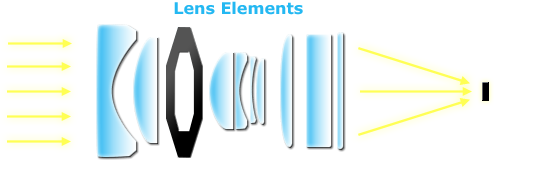
Optical aberrations occur when points in the prototype exercise not interpret back onto single points after passing through the lens — causing epitome blurring, reduced contrast or misalignment of colors (chromatic aberration). Lenses may likewise suffer from uneven, radially decreasing image effulgence (vignetting) or baloney. Move your mouse over each of the options below to see how these tin can affect image quality in extreme cases:

Original Paradigm

| Loss of Contrast | Blurring |
| Chromatic Aberration | Distortion |
| Vignetting | Original |
Any of the higher up problems is nowadays to some degree with any lens. In the residual of this tutorial, when a lens is referred to as having lower optical quality than another lens, this is manifested every bit some combination of the above artifacts. Some of these lens artifacts may not be every bit objectionable as others, depending on the subject field matter.
Note: For a more quantitative and technical discussion of the above topic, delight see the
tutorial on camera lens quality: MTF, resolution & contrast.
INFLUENCE OF LENS FOCAL LENGTH
The focal length of a lens determines its angle of view, and thus too how much the subject will be magnified for a given photographic position. Wide angle lenses have short focal lengths, while telephoto lenses accept longer corresponding focal lengths.
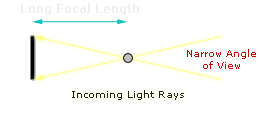
Note: The location where lite rays cantankerous is not necessarily equal to the focal length,
equally shown above, just is instead roughly proportional to this distance.
Note: Reckoner assumes that camera is oriented such that the maximum
field of study dimension given by "subject size" is in the photographic camera's longest dimension.
Calculator not intended for use in extreme macro photography.
Many will say that focal length also determines the perspective of an epitome, just strictly speaking, perspective only changes with ane's location relative to their subject. If one tries to make full the frame with the same subjects using both a wide angle and telephoto lens, and then perspective does indeed change, considering one is forced to movement closer or further from their subject. For these scenarios only, the broad angle lens exaggerates or stretches perspective, whereas the telephoto lens compresses or flattens perspective.
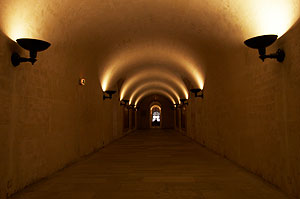
Perspective control tin be a powerful compositional tool in photography, and frequently determines 1'due south option in focal length (when one tin photo from any position). Move your mouse over the to a higher place image to view an exaggerated perspective due to a wider angle lens. Note how the subjects within the frame remain near identical — therefore requiring a closer position for the wider angle lens. The relative sizes of objects change such that the distant doorway becomes smaller relative to the nearby lamps.
The post-obit tabular array provides an overview of what focal lengths are required to be considered a wide angle or telephoto lens, in improver to their typical uses. Please note that focal lengths listed are merely rough ranges, and actual uses may vary considerably; many use telephoto lenses in distant landscapes to compress perspective, for instance.
| Lens Focal Length* | Terminology | Typical Photography |
|---|---|---|
| Less than 21 mm | Extreme Wide Angle | Architecture |
| 21-35 mm | Wide Angle | Landscape |
| 35-70 mm | Normal | Street & Documentary |
| 70-135 mm | Medium Telephoto | Portraiture |
| 135-300+ mm | Telephoto | Sports, Bird & Wildlife |
*Note: Lens focal lengths are for 35 mm equivalent cameras. If you have a meaty or digital SLR camera, then you likely have a different sensor size. To adapt the above numbers for your camera, please use the focal length converter in the tutorial on digital camera sensor sizes.
Other factors may also be influenced by lens focal length. Telephoto lenses are more than susceptible to camera milk shake since small hand movements go magnified, similar to the shakiness experience while trying to look through binoculars. Broad bending lenses are more often than not more resistant to flare, in part because the designers assume that the sun is more likely to be within the frame. A final consideration is that medium and telephoto lenses generally yield better optical quality for similar price ranges.
FOCAL LENGTH & HANDHELD PHOTOS
The focal length of a lens may as well have a significant impact on how easy information technology is to achieve a sharp handheld photograph. Longer focal lengths crave shorter exposure times to minimize blurring caused by shaky hands. Call back of this as if one were trying to hold a laser pointer steady; when shining this pointer at a nearby object its bright spot ordinarily jumps around less than for objects farther abroad.

This is primarily because slight rotational vibrations are magnified profoundly with distance, whereas if just upwards and down or side to side vibrations were present, the laser's brilliant spot would not modify with distance.

A common rule of thumb for estimating how fast the exposure needs to be for a given focal length is the one over focal length rule. This states that for a 35 mm camera, the exposure time needs to be at least equally fast as i over the focal length in seconds. In other words, when using a 200 mm focal length on a 35 mm photographic camera, the exposure time needs to be at to the lowest degree 1/200 seconds — otherwise blurring may exist hard to avoid. Meet the tutorial on reducing camera shake with hand-held photos for more than on this topic.
Keep in mind that this dominion is only for crude guidance; some may be able to mitt hold a shot for much longer or shorter times. For users of digital cameras with cropped sensors, i needs to convert into a 35 mm equivalent focal length.
ZOOM LENSES vs. PRIME LENSES
A zoom lens is 1 where the photographer can vary the focal length within a pre-defined range, whereas this cannot be inverse with a "prime" or stock-still focal length lens. The chief advantage of a zoom lens is that it is easier to accomplish a diversity of compositions or perspectives (since lens changes are not necessary). This reward is often critical for dynamic bailiwick affair, such as in photojournalism and children'due south photography.
Keep in listen that using a zoom lens does not necessarily hateful that ane no longer has to change their position; zooms just increase flexibility. In the instance below, the original position is shown forth with 2 alternatives using a zoom lens. If a prime lens were used, then a change of composition would non have been possible without cropping the prototype (if a tighter composition were desirable). Like to the example in the previous department, the change of perspective was achieved by zooming out and getting closer to the subject. Alternatively, to achieve the opposite perspective effect, 1 could have zoomed in and moved farther from the subject.
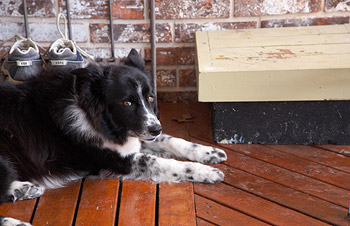 | |
| 2 Options Available with a Zoom Lens: | |
| Change of Composition | Change of Perspective |
Why would one intentionally restrict their options past using a prime lens?Prime lenses existed long before zoom lenses were bachelor, and still offer many advantages over their more than mod counterparts. When zoom lenses first arrived on the market, ane ofttimes had to be willing to sacrifice a meaning amount of optical quality. Nonetheless, more contempo high-end zoom lenses generally practise not produce noticeably lower image quality, unless scrutinized by the trained eye (or in a very large print).
The primary advantages of prime lenses are in cost, weight and speed. An inexpensive prime number lens can generally provide as expert (or meliorate) epitome quality every bit a high-terminate zoom lens. Additionally, if only a pocket-sized fraction of the focal length range is necessary for a zoom lens, then a prime lens with a similar focal length will be significantly smaller and lighter. Finally, the best prime lenses nearly ever offer better low-cal-gathering ability (larger maximum aperture) than the fastest zoom lenses — oftentimes disquisitional for low-light sports/theater photography, and when a shallow depth of field is necessary.
For compact digital cameras, lenses listed with a 3X, 4X, etc. zoom designation refer to the ratio betwixt the longest and shortest focal lengths. Therefore, a larger zoom designation does not necessarily mean that the image can be magnified whatsoever more (since that zoom may just have a wider angle of view when fully zoomed out). Additionally, digital zoom is not the same every bit optical zoom, every bit the former only enlarges the epitome through interpolation. Read the fine-print to ensure you are not misled.
INFLUENCE OF LENS APERTURE OR F-NUMBER
The discontinuity range of a lens refers to the amount that the lens can open up up or close down to let in more or less light, respectively. Apertures are listed in terms of f-numbers, which quantitatively draw relative light-gathering area (depicted below).

Notation: Aperture opening (iris) is rarely a perfect circle,
due to the presence of v-8 blade-similar lens diaphragms.
Annotation that larger discontinuity openings are defined to have lower f-numbers (oft very confusing). These two terms are often mistakenly interchanged; the rest of this tutorial refers to lenses in terms of their aperture size. Lenses with larger apertures are likewise described as beingness "faster," because for a given ISO speed, the shutter speed can be made faster for the same exposure. Additionally, a smaller aperture means that objects tin can exist in focus over a wider range of distance, a concept likewise termed the depth of field.
| Influence on Other Backdrop: | ||||
| f/# | Lite-Gathering Expanse (Aperture Size) | Required Shutter Speed | Depth of Field | |
|---|---|---|---|---|
| Higher | Smaller | Slower | Wider | |
| Lower | Larger | Faster | Narrower | |
When one is considering purchasing a lens, specifications commonly list the maximum (and maybe minimum) bachelor apertures. Lenses with a greater range of aperture settings provide greater creative flexibility, in terms of both exposure options and depth of field. The maximum discontinuity is perhaps the most important lens aperture specification, which is oftentimes listed on the box along with focal length(s).
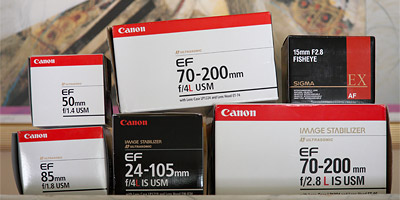
An f-number of Ten may also exist displayed as ane:Ten (instead of f/Ten), every bit shown below for the Canon 70-200 f/2.eight lens (whose box is also shown above and lists f/2.eight).

Portrait and indoor sports/theater photography often requires lenses with very big maximum apertures, in lodge to be capable of a narrower depth of field or a faster shutter speed, respectively. The narrow depth of field in a portrait helps isolate the discipline from their background. For digital SLR cameras, lenses with larger maximum apertures provide significantly brighter viewfinder images — possibly critical for nighttime and low-calorie-free photography. These also often give faster and more than authentic auto-focusing in low-calorie-free. Transmission focusing is also easier because the image in the viewfinder has a narrower depth of field (thus making it more visible when objects come into or out of focus).
| Typical Maximum Apertures | Relative Low-cal-Gathering Ability | Typical Lens Types |
|---|---|---|
| f/1.0 | 32X | Fastest Bachelor Prime Lenses (for Consumer Use) |
| f/1.iv | 16X | Fast Prime Lenses |
| f/2.0 | 8X | |
| f/ii.eight | 4X | Fastest Zoom Lenses (for Constant Aperture) |
| f/4.0 | 2X | Light Weight Zoom Lenses or Extreme Telephoto Primes |
| f/5.six | 1X |
Minimum apertures for lenses are generally nowhere nearly as important as maximum apertures. This is primarily because the minimum apertures are rarely used due to photo blurring from lens diffraction, and considering these may crave prohibitively long exposure times. For cases where extreme depth of field is desired, then smaller minimum aperture (larger maximum f-number) lenses let for a wider depth of field.
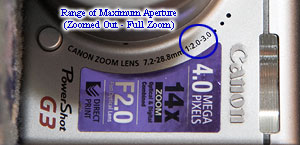
Finally, some zoom lenses on digital SLR and meaty digital cameras often list a range of maximum aperture, because this may depend on how far i has zoomed in or out. These aperture ranges therefore refer only to the range of maximum aperture, non overall range. A range of f/2.0-three.0 would hateful that the maximum available discontinuity gradually changes from f/2.0 (fully zoomed out) to f/iii.0 (at full zoom). The primary benefit of having a zoom lens with a constant maximum discontinuity is that exposure settings are more predictable, regardless of focal length.
Besides annotation that just considering the maximum discontinuity of a lens may not exist used, this does not necessarily hateful that this lens is non necessary. Lenses typically take fewer aberrations when they perform the exposure stopped down i or two f-stops from their maximum discontinuity (such as using a setting of f/four.0 on a lens with a maximum aperture of f/two.0). This *may* therefore mean that if one wanted the best quality f/2.eight photo, a f/2.0 or f/i.iv lens may yield college quality than a lens with a maximum aperture of f/2.8.
Other considerations include toll, size and weight. Lenses with larger maximum apertures are typically much heavier, larger and more expensive. Size/weight may be critical for wild animals, hiking and travel photography because all of these ofttimes apply heavier lenses, or require carrying equipment for extended periods of time.
Further READING
For more on camera lenses, also visit the following tutorials:
- Using Broad Angle Lenses
- Using Telephoto Lenses
- Macro Lenses: Magnification, Depth of Field & Effective F-Terminate





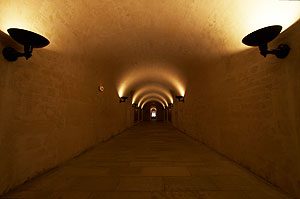
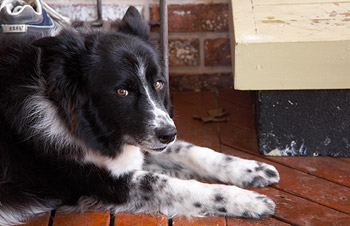

Source: https://www.cambridgeincolour.com/tutorials/camera-lenses.htm
Posted by: cortezsorm2002.blogspot.com


0 Response to "Are Camera Lenses Fixed Assests"
Post a Comment